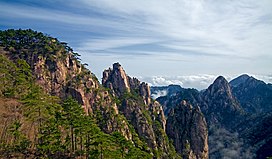
Back جبل هوانغشان Arabic جبل هوانجشان ARZ Montes Huang AST Хуаншан Bulgarian ཧོང་ཧྲན་རི་བོ། Tibetan Huang Shan Catalan Huang Shan (kabukiran) CEB Žluté hory Czech Huangshan Danish Huang Shan German
| Huangshan 黄山 | |
|---|---|
 Panoramic view of the Huangshan landscape | |
| Highest point | |
| Elevation | 1,864 m (6,115 ft)[1] |
| Prominence | 1,734 m (5,689 ft)[1] |
| Listing | Ultra, Ribu |
| Coordinates | 30°07′30″N 118°10′00″E / 30.12500°N 118.16667°E[1] |
| Geography | |
| Location | Huangshan City, Anhui |
| Official name | Mount Huangshan |
| Criteria | Cultural and Natural: (ii), (vii), (x) |
| Reference | 547bis |
| Inscription | 1990 (14th Session) |
| Extensions | 2012 |
| Area | 16,060 ha (62.0 sq mi) |
| Buffer zone | 49,000 ha (190 sq mi) |
| Huangshan | |||||||||||||||||||||||||
|---|---|---|---|---|---|---|---|---|---|---|---|---|---|---|---|---|---|---|---|---|---|---|---|---|---|
 "Huangshan" in Simplified (top) and Traditional (bottom) Chinese characters | |||||||||||||||||||||||||
| Simplified Chinese | 黄山 | ||||||||||||||||||||||||
| Traditional Chinese | 黄山 | ||||||||||||||||||||||||
| Literal meaning | "Yellow Mountain(s)" | ||||||||||||||||||||||||
| |||||||||||||||||||||||||
Huangshan (Chinese: 黄山),[2] literally meaning the Yellow Mountain(s), is a mountain range in southern Anhui province in eastern China. It was originally called "Yishan", and it was renamed because of a legend that Emperor Xuanyuan once made alchemy here.[3] Vegetation on the range is thickest below 1,100 meters (3,600 ft), with trees growing up to the treeline at 1,800 meters (5,900 ft).
The area is well known for its scenery, sunsets, peculiarly-shaped granite peaks, Huangshan pine trees, hot springs, winter snow and views of the clouds from above. Huangshan is a frequent subject of traditional Chinese paintings and literature, as well as modern photography. It is a UNESCO World Heritage Site and one of China's major tourist destinations.
- ^ a b c "Lianhua Feng - Lotus Peak, HP Huang Shan" on Peaklist.org - Central and Eastern China, Taiwan and Korea. This data is specific to the high point of the range only. Retrieved 2011-10-5.
- ^ Bernstein, pp. 125–127.
- ^ "Origins and new interpretations on the theory of Pleistocene glaciation in South-East China - the case of the Lushan and Huangshan ranges". Annales de Géographie. 101: 472.

